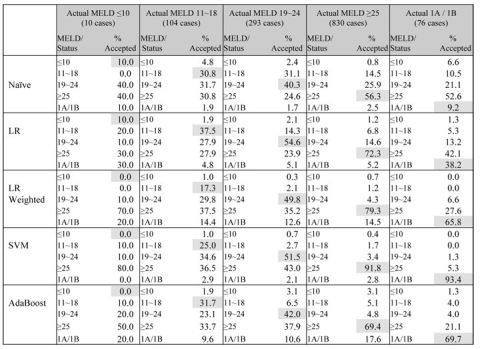Accept/Decline Decisions for Deceased Donor Liver Allografts
Scientific Registry of Transplant Recipients, Minneapolis Medical Research Foundation, Minneapolis, MN
Industrial &
Systems Engineering, University of Minnesota, Minneapolis, MN
Meeting: 2013 American Transplant Congress
Abstract number: D1639
Simulated allocation models (SAMs) are computer programs used by OPTN/UNOS to evaluate the impact of new allocation policies on distribution of organs and on wait-list and posttransplant outcomes. These programs should predict whether a candidate will accept an offered organ under the new allocation policy. The predictive model should reproduce results similar to those observed in practice but not rely completely on the attributes of current policy.
Methods: The predictive model to determine whether a candidate will accept an organ in the SAMs is logistic regression (LR). We used match run data for liver offers and tested three methods: LR, support vector machines (SVM), and AdaBoost (an ensemble approach). The algorithms were trained on the same data subset and tested on a different subset to compare their accuracy. The straw-man approach is called the naÏve method. It predicts an “accept” decision with probability equal to the proportion of “accept” decisions in the test data.
Results: The match run data are highly imbalanced with many more decline than accept decisions per organ, making accurate prediction difficult. We tested the three approaches for run times, accuracy (sensitivity and specificity), MELD score distribution, local/regional/national distribution, and Status 1A/not 1A distribution. These comparisons highlight the extent to which each methodology produces outcomes similar to those observed in actual data. The table below shows MELD score comparisons.

Conclusions: SVM was the most accurate method for MELD ≥ 25 and 1A/1B candidates, who together make up the vast majority of cases. SVM was also more accurate in predicting the distribution of local/regional/national allocations and 1A/not 1A distribution of allocated organs. SVM is more accurate but computationally demanding and it takes significantly longer to train. However, once it is trained, the effort needed to predict an outcome for a particular donor-candidate pair is similar across all methods tested.
To cite this abstract in AMA style:
Gupta D, Kim S, Zhang Z, Gustafson S, Salkowski N, Snyder J, Kasiske B, Israni A. Accept/Decline Decisions for Deceased Donor Liver Allografts [abstract]. Am J Transplant. 2013; 13 (suppl 5). https://atcmeetingabstracts.com/abstract/acceptdecline-decisions-for-deceased-donor-liver-allografts/. Accessed December 25, 2025.« Back to 2013 American Transplant Congress
